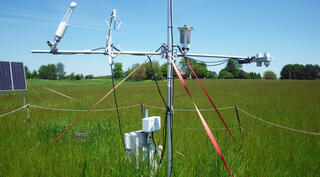Bioenergy crops create local cooling that can increase climate benefit

Higher surface reflectivity of switchgrass and other bioenergy crops can help offset the climate impact associated with converting grassland to bioenergy crops.
The Science
Biofuels can offer considerable climate benefits over fossil fuels, but large-scale bioenergy crop production requires a significant amount of land. In the US, those land requirements will likely be met in part by converting Conservation Reserve Program (CRP) grassland to bioenergy cropping systems. Land use changes on that scale have implications for mitigating the impacts of climate change. A cropping system’s global warming impact (GWI), a measure of climate change, is usually calculated based on the uptake and release of compounds containing carbon, such as carbon dioxide, and nitrogen, such as nitrous oxide. A research team at the Great Lakes Bioenergy Research Center (GLBRC) has developed a way to measure GWI associated with albedo, which calculates how well a crop’s surface reflectivity cools the local climate. A new study shows that albedo-induced climate mitigation from conversion of CRP lands to perennial bioenergy crops like switchgrass and restored prairie can be substantial. This approach can inform new estimates of the net climate impacts of bioenergy cropping systems.
The Impact
Twelve million acres of CRP grasslands have been converted to croplands—mainly for corn bioenergy—since 2000. Climate benefit analyses for these conversions have not historically included albedo as a factor in GWI estimations. However, land conversions for large-scale bioenergy crops have the potential to considerably change local climates. This makes albedo differences for bioenergy crops an important component for modeling the impact of land conversion. The public, policymakers, and farmers can use this information to decide which crops to support, fund, and plant.
Summary
A 2019 study by the same team of GLBRC researchers used carbon and nitrogen calculations to estimate the climate impact of farming former conservation lands. The study concluded that converting CRP land to corn results in an over 300-year carbon debt—it would take 300 years of growing corn on the land to offset the net carbon emissions associated with turning it into cornfields. Switchgrass or restored prairie plantings initially lose carbon but show a net gain—meaning positive climate effects—within eight to ten years.
In the new study, the researchers added albedo-associated climate effects to their calculations. All three of the bioenergy crops studied have higher albedo than CRP grasslands, giving a larger cooling effect on the local climate than previously thought. For switchgrass and restored prairie, albedo caused 35% and 78% as much net cooling, respectively, as the previously measured biochemical changes associated with land conversion. For corn, the climate benefits caused by albedo pale in comparison to the carbon debt caused by conversion from CRP grassland and occurred almost exclusively in winter, leading to no difference in net cooling or warming in summer. For conversions to restored prairie, the albedo-induced local cooling was sufficient to offset the warming impact from nitrous oxide emissions and farming inputs combined. Accounting for cooling due to albedo will allow scientists to predict the net climate impact of converting grasslands more accurately for bioenergy feedstocks. These estimates will better inform public opinion and climate policy and help farmers earn more carbon credits for bioenergy crops.
Program Manager
N. Kent Peters
Program Manager, Office of Biological and Environmental Research
kent.peters@science.doe.gov, 301-903-5549
Corresponding Authors
Michael Abraha
Michigan State University
abraha@msu.edu
Jiquan Chen
Michigan State University
jqchen@msu.edu
Funding
Support for this research was provided by the Great Lakes Bioenergy Research Center, U.S. Department of Energy, Office of Science, Office of Biological and Environmental Research (Award DE-SC0018409 and DE-FC02-07ER64494), by the National Science Foundation Long-term Ecological Research Program (DEB 1832042 and DEB 1637653) and USDA Long-term Agroecosystem Research Program at the Kellogg Biological Station, and by Michigan State University AgBioResearch.
Publications
Abraha, M., Chen, J., Hamilton, S., Sciusco, P., Lei, C., Shirkey, G., Yuan, J., Robertson, G.P., “Albedo-induced global warming impact of Conservation Reserve Program grasslands converted to annual and perennial bioenergy crops.” Environmental Research Letters 16:8 (2021) [DOI: 10.1088/1748-9326/ac1815]
Abraha, M., Gelfand, I., Hamilton, S., Chen, J., Robertson, G.P., “Carbon debt of field-scale conservation reserve programs grasslands converted to annual and perennial bioenergy crops.” Environmental Research Letters 14:2 (2019) [DOI: 10.1088/1748-9326/aafc10]